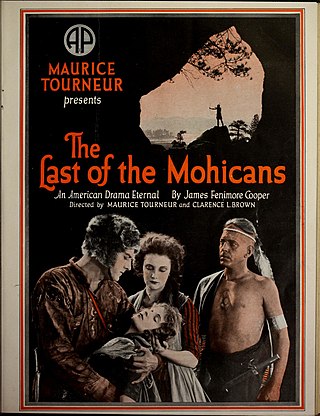
The Last of the Mohicans is a 1920 American silent adventure drama film written by Robert A. Dillon, adapted from James Fenimore Cooper's 1826 novel of the same name. Clarence Brown and Maurice Tourneur co-directed the film. It is a story of two English sisters meeting danger on the frontier of the American colonies, in and around the fort commanded by their father. The adventure film stars Wallace Beery, Barbara Bedford, Lillian Hall, Alan Roscoe and Boris Karloff in one of his earliest silent film roles. Barbara Bedford later married her co-star in the film, Alan Roscoe in real life. The production was shot near Big Bear Lake and in Yosemite Valley.

Robert Osbourne Denver was an American comedic actor who portrayed Gilligan on the 1964–1967 television series Gilligan's Island, and beatnik Maynard G. Krebs on the 1959–1963 series The Many Loves of Dobie Gillis.

Lee Ann Remick was an American actress and singer. She was nominated for the Academy Award for Best Actress for the film Days of Wine and Roses (1962).
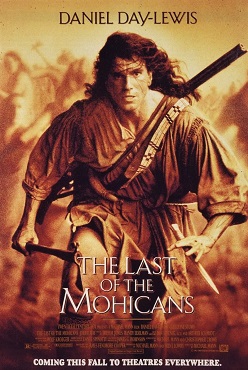
The Last of the Mohicans is a 1992 American epic historical action drama film directed by Michael Mann, who co-wrote the screenplay with Christopher Crowe, based on the 1826 novel of the same name by James Fenimore Cooper and its 1936 film adaptation. The film is set in 1757 during the French and Indian War. It stars Daniel Day-Lewis, Madeleine Stowe, and Jodhi May.

Dusty's Trail is an American Western/comedy series starring Bob Denver and Forrest Tucker that aired in syndication from September 1973 to March 1974. The series is a western-themed reworking of Denver's previous series Gilligan's Island.

Wagons East is a 1994 American Western adventure comedy film directed by Peter Markle, written by Matthew Carlson, and starring John Candy, Richard Lewis, John C. McGinley, Ellen Greene, Robert Picardo, Rodney A. Grant, and Ed Lauter. It tells the story of an alcoholic wagon master who leads a group of misfit settlers in the Wild West back to the East. The film was released in the United States on August 26, 1994. Filming took place in Sierra de Órganos National Park in the town of Sombrerete, Mexico, and in Durango, Mexico.

Alfred Morton Bridge was an American character actor who played mostly small roles in over 270 films between 1931 and 1954. Bridge's persona was an unpleasant, gravel-voiced man with an untidy moustache. Sometimes credited as Alan Bridge, and frequently not credited onscreen at all, he appeared in many westerns, especially in the Hopalong Cassidy series, where he played crooked sheriffs and henchmen.
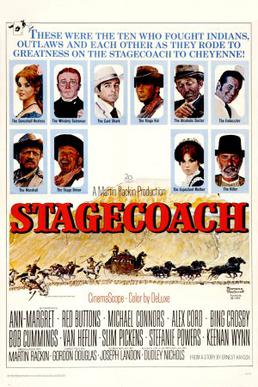
Stagecoach is a 1966 American Western film, directed by Gordon Douglas between July and September 1965, as a color remake of the Academy Award-winning John Ford 1939 classic black-and-white western Stagecoach. Unlike the original version which listed its ten leading players in order of importance, the major stars are billed in alphabetical order.

Allan "Rocky" Lane was an American studio leading man and the star of many cowboy B-movies in the 1940s and 1950s. He appeared in more than 125 films and TV shows in a career lasting from 1929 to 1966. He is best known for his portrayal of Red Ryder and for being the voice of the talking horse on the television series Mister Ed, beginning in 1961.

7th Cavalry is a 1956 American Western film directed by Joseph H. Lewis based on a story, "A Horse for Mrs. Custer," by Glendon Swarthout set after the Battle of the Little Big Horn. Filmed in Mexico, the picture stars Randolph Scott and Barbara Hale.

Escape from Fort Bravo is a 1953 American Anscocolor Western film set during the American Civil War. Directed by John Sturges it stars William Holden, Eleanor Parker, and John Forsythe.

The Walking Hills is a 1949 American Western film directed by John Sturges and starring Randolph Scott and Ella Raines. The film's plot has film noir elements in its story of a search for an old treasure by nine men including a detective tracking a fugitive, several others who have things to hide, and a love triangle involving the two leads and the fugitive.

Billy Two Hats is a 1974 American Western film directed by Ted Kotcheff. It stars Gregory Peck, Jack Warden and Desi Arnaz, Jr.
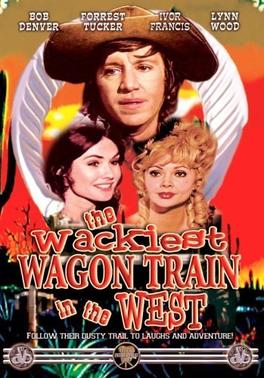
The Wackiest Wagon Train in the West is a 1976 American Western comedy film directed by Jack Arnold. The film stars Bob Denver as Dusty, the bumbling assistant to Wagonmaster Callahan featured in the syndicated series Dusty's Trail.
Nicholas "Nick" J. Corea was an American author, television writer, director, producer and painter. Though best known for his work on The Incredible Hulk and its sequel 1988 telefilm The Incredible Hulk Returns, he was involved with many television series during the late 1970s and 1980s including The Oregon Trail, Airwolf, Street Hawk, Hard Time on Planet Earth and Booker. He was also the creator of the 1986 western series Outlaws.

Pillars of the Sky is a 1956 American CinemaScope western film directed by George Marshall and starring Jeff Chandler, Dorothy Malone and Ward Bond. It was produced and distributed by Universal Pictures.

South Platte Trail was a historic trail that followed the southern side of South Platte River from Fort Kearny in Nebraska to Denver, Colorado. Plains Indians, such as the Cheyenne and the Arapaho, hunted in the lands around the South Platte River. They also traded at trading posts along the route, as did white travelers. Travelers included trappers, traders, explorers, the military, and those following the gold rush. The trail was also used by the Pony Express.

Old Overland Trail is a 1953 American Western film directed by William Witney and written by Milton Raison. The film stars Rex Allen, Slim Pickens, Roy Barcroft, Virginia Hall, Gil Herman and Wade Crosby. The film was released on February 25, 1953, by Republic Pictures.

Fort Wicked was a ranch and stage station on the Overland Trail from 1864 to 1868 in present-day Merino, Colorado. A historical marker commemorating the ranch is located at US 6 and CR-2.5. The ranch itself was located near a ford of the South Platte River, near where US-6 now crosses over the river. Fort Wicked was one of the few places along the trail to Denver that withstood an attack by Lakota, Cheyenne, and Arapaho Native Americans in the Colorado War of 1864. It was named Fort Wicked for the "bitter defence" made by Holon Godfrey, his family, and his employees.
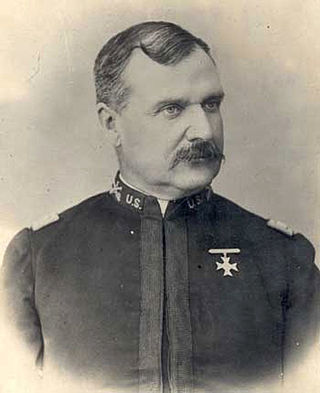
Homer W. Wheeler was an American military officer and author. A veteran of the American Indian Wars and Spanish–American War, he attained the rank of colonel and wrote several books, including memoirs of his experiences on the western frontier of the United States in the late 1800s.



















